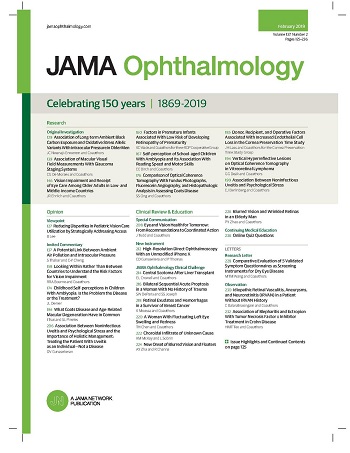多因素干预对2型糖尿病视网膜病变的影响:J-DOIT3随机临床试验的二次分析
IF 9.2
1区 医学
Q1 OPHTHALMOLOGY
引用次数: 0
摘要
预防糖尿病视网膜病变对保持视力和生活质量至关重要。目的探讨强化多因素干预和低血糖治疗对2型糖尿病视网膜病变的影响。设计、环境和参与者j - doit3(日本糖尿病3种主要心血管疾病危险因素的最佳综合治疗研究)是一项多中心、开放标签、平行组随机临床试验,旨在研究强化多因素干预对45 - 69岁伴有高血压和/或血脂异常的2型糖尿病患者心血管结局和死亡率的影响。该研究于2006年6月至2009年3月在日本的81个地点进行,并于2018年9月至2025年8月进行了数据分析。干预措施:参与者被随机分配到强化血糖、血压和血脂治疗组或常规治疗组,随访时间中位数为8.5年。本研究是对视网膜病变事件的次要结果的次要分析,包括视网膜病变的发病、视网膜病变的进展和可能由视网膜病变引起的视力丧失。结果2540例(5080只眼)随机分为强化治疗组和常规治疗组,平均(SD)年龄为59.0(6.3)岁,女性965例(38.0%)。强化治疗与视网膜病变发病风险降低相关(风险比[HR], 0.83; 95% CI, 0.70-0.98; P =。03),但与视网膜病变的进展无关(HR, 1.02; 95% CI, 0.70-1.49; P = 0.93)。随机分组后1年的糖化血红蛋白(HbA1c)与发病相关(HR, 1.31; 95% CI, 1.13-1.51; P <。001),即使在调整了基线危险因素(即较低的体重指数、较长的糖尿病病程、较高的空腹血糖、较高的血压和合并症肾病)之后,也没有观察到明确的HbA1c阈值。此外,与干预期间没有低血糖发作的患者相比,每年低血糖发作0.5次或更少的患者发病风险更高(HR, 1.25; 95% CI, 1.02-1.53),而每年低血糖发作1次以上的患者发病风险更高(HR, 1.85; 95% CI, 1.39-2.47)。J-DOIT3随机临床试验的二级分析显示,在随机临床试验环境中,高HbA1c和非严重低血糖与2型糖尿病患者视网膜病变发病的高风险相关,即使在实现了良好的血糖管理和极低的严重低血糖发生率的情况下,这表明严格的血糖管理和无低血糖的重要性。试验注册:clinicaltrials .gov标识符:NCT00300976。本文章由计算机程序翻译,如有差异,请以英文原文为准。
Effect of a Multifactorial Intervention on Retinopathy in People With Type 2 Diabetes: A Secondary Analysis of the J-DOIT3 Randomized Clinical Trial.
Importance
Prevention of diabetic retinopathy is important to keep vision and quality of life.
Objective
To examine the effects of an intensive multifactorial intervention and hypoglycemia on retinopathy in people with type 2 diabetes.
Design, Setting, and Participants
J-DOIT3 (Japan Diabetes Optimal Integrated Treatment Study for 3 Major Risk Factors of Cardiovascular Diseases) is a multicenter, open-label, parallel-group randomized clinical trial that examined the efficacy of an intensified multifactorial intervention on cardiovascular outcomes and mortality in people with type 2 diabetes aged 45 to 69 years with hypertension and/or dyslipidemia. The study was conducted at 81 sites in Japan from June 2006 to March 2009, and data analysis was performed from September 2018 to August 2025.
Interventions
Participants were randomly assigned to intensive therapy for glucose, blood pressure, and lipids or conventional therapy and were followed up for a median duration of 8.5 years.
Main Outcomes and Measures
This study is a secondary analysis of retinopathy events of the secondary outcomes, composed of onset of retinopathy, progression of retinopathy, and loss of vision likely due to retinopathy.
Results
Among 2540 total participants (5080 eyes) randomly assigned to intensive therapy or conventional therapy, mean (SD) age was 59.0 (6.3) years, and 965 participants (38.0%) were female. Intensive therapy was associated with a risk reduction in onset of retinopathy (hazard ratio [HR], 0.83; 95% CI, 0.70-0.98; P = .03) but not with progression of retinopathy (HR, 1.02; 95% CI, 0.70-1.49; P = .93). Hemoglobin A1c (HbA1c) at 1 year after randomization was associated with onset (HR, 1.31; 95% CI, 1.13-1.51; P < .001), even after adjustment for baseline risk factors (ie, lower body mass index, longer duration of diabetes, higher fasting plasma glucose, higher blood pressure, and comorbid nephropathy), with no clear HbA1c threshold observed. Moreover, compared with those without a hypoglycemic episode during the intervention, the risk of onset was higher in those with 0.5 hypoglycemic episodes per year or fewer (HR, 1.25; 95% CI, 1.02-1.53) and even higher in those with more than 1 hypoglycemic episode per year (HR, 1.85; 95% CI, 1.39-2.47).
Conclusions and Relevance
This secondary analysis of the J-DOIT3 randomized clinical trial shows that in a randomized clinical trial setting, higher HbA1c and nonsevere hypoglycemia are associated with higher risk of onset of retinopathy in people with type 2 diabetes, even when good glycemic management, with a very low incidence of severe hypoglycemia, is achieved, suggesting the importance of strict glycemic management without any hypoglycemia.
Trial Registration
ClinicalTrials.gov Identifier: NCT00300976.
求助全文
通过发布文献求助,成功后即可免费获取论文全文。
去求助
来源期刊

JAMA ophthalmology
OPHTHALMOLOGY-
CiteScore
13.20
自引率
3.70%
发文量
340
期刊介绍:
JAMA Ophthalmology, with a rich history of continuous publication since 1869, stands as a distinguished international, peer-reviewed journal dedicated to ophthalmology and visual science. In 2019, the journal proudly commemorated 150 years of uninterrupted service to the field. As a member of the esteemed JAMA Network, a consortium renowned for its peer-reviewed general medical and specialty publications, JAMA Ophthalmology upholds the highest standards of excellence in disseminating cutting-edge research and insights. Join us in celebrating our legacy and advancing the frontiers of ophthalmology and visual science.
 求助内容:
求助内容: 应助结果提醒方式:
应助结果提醒方式:


